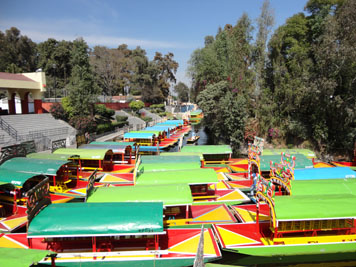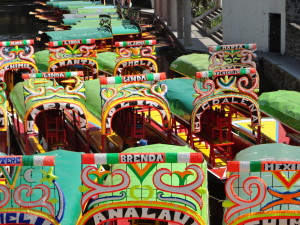Xochimilco is a Nahua word that is difficult to translate literally. It is a compound word: “xóchitl” means flower and “milco” means place. However, when put together, the meaning of the word is not simply place of flowers. The combination of the two allows a verb to emerge. This verb is related to fertility; Xochimilco means “sowing land in blossom”(Delegacion Xochimilco, Turismo).
The Xochimilco channels are the last remains of the great lake of Texcoco, where the Aztecs built the City of Tenochtitlán in 1325. Xochimilco forms part of UNESCO’s world heritage list. In the list, Xochimilco is described as follows:
[Xochimilco] is the only remaining reminder of the lacustrine landscape of the Aztec capital, where the conquistadores destroyed the monuments and drained the canals. On the edge of the residual lake of Xochimilco (the southern arm of the great dried-up lake of Texcoco where the Aztecs had settled on a group of islets linked to solid ground by footbridges), and in the midst of a network of small canals, are still some chinampas, the floating gardens that the Spanish so admired. This half-natural, half-artificial landscape is now an ‘ecological reserve.’ (UNESCO, World Heritage List, Historic Center of Mexico and Xochimilco)
The Delegacion Xochimilco (or the Xochimilco District) is one of the rural areas of Mexico City. Its soil is very fertile because of the water channels. This characteristic, combined with the warm and sunny weather, allows for the production of flowers and plants of many sorts. As stated before, Xochimilco is currently both a natural reserve and a tourist destination. Visitors enjoy a ride in a trajinera, a wooden boat large enough to hold tables and chairs. Sometimes, entire mariachi bands can be found playing on trajineras navigating along the Xochimilco channels.
Veronica Sahagun ( 2011). Nativitas Dock in the Xochimilco Channels.
This land of blossoming flowers holds a special place in my memories of Central Mexico. It transports me to my years as a visual arts student at the Escuela Nacional de Artes Plasticas, which is located in the same area. Those years were full of of self-discovery and learning. As an art student, I would often visit the flower markets as well as the docks. I would usually take photographs or make quick sketches of the main square, the food, and the flower market stands. Along with other art students, I would rent a trajinera and navigate the channels looking for interesting sites to draw.
The last time that I visited one of Xochimilco’s docks was on December 2011. I felt disheartened to find it empty and deteriorated. There were no costumers, just a few trajinera owners, who tried to persuade me to take a ride. The empty dock made me feel depressed and hopeless. I think that people in my city are feeling powerless and see no point in changing or fixing things. They prefer to invest their efforts in other activities that may ensure economical survival. From my perspective the prevailing corruption within government institutions makes people feel helpless. They do not trust that the government will commit to improve the economy or provide security. Therefore, Mexican people are getting used to improvising and solving their problems according to their own possibilities. As I see it, the physical deterioration of city’s architecture makes it even harder for people to keep a positive outlook. For me, sites like the Xochimilco dock are indicators of Mexican peoples’ emotional and mental states. Citizens are forced to live their lives in an almost passive way for fear that things may go even worse.
Veronica Sahagun (2011). Tajineras in Dock.
When I was a child, the trajineras’ signs were made out of real flowers. Now I see that they use colored paper and paint. They are flat and sad. I was very lucky to have been raised in a Mexico that was still very alive. Traditions were strong and people were proud of them. In the mid 1990’s people started talking about globalization. They said that this new political system was going to threaten the local cultures. At that point, I did not understand why. More than 10 years later, I see how the laws of a globalized market have forced rural workers and artisans to change their ways of working and lower the standards of their products in order to survive.
The atmosphere in Xochimilco was similar to what I noticed in other parts of the city. This shift was difficult for me to accept; during the Christmas holidays, the city is generally very busy with parties and people buying gifts. Instead, I saw military buses and police vehicles passing through the main streets of the city. I sensed that people were increasingly afraid to leave their houses.
References
United Nations Educational Scientific and Cultural Organization.(2013).Retrieved September 23, 2013, from http://whc.unesco.org/en/list
Xochimilco, patrimonio cultural y natural de la humanidad. (2013). Retrieved September 23, 2013, from http://www.xochimilco.df.gob.mx/turismo/index.html

